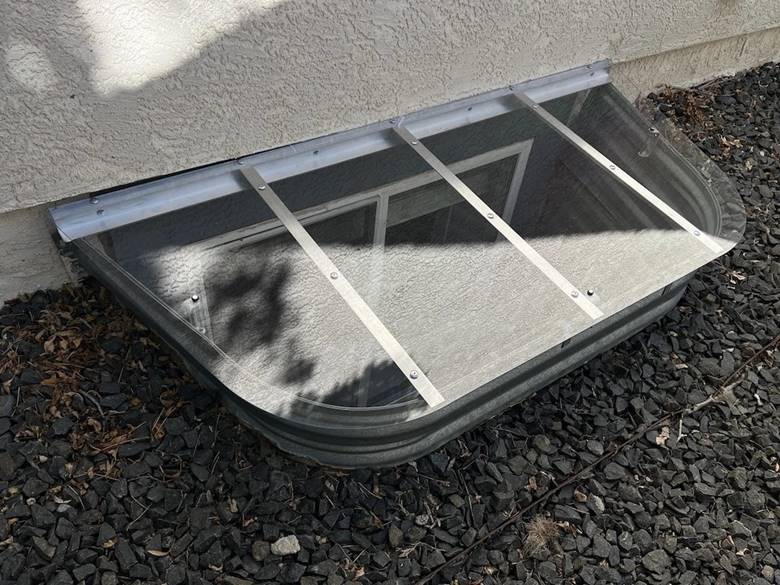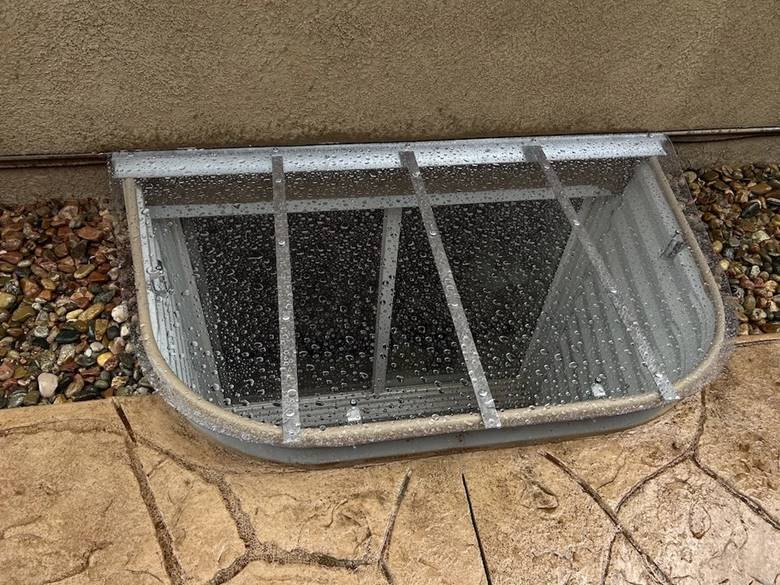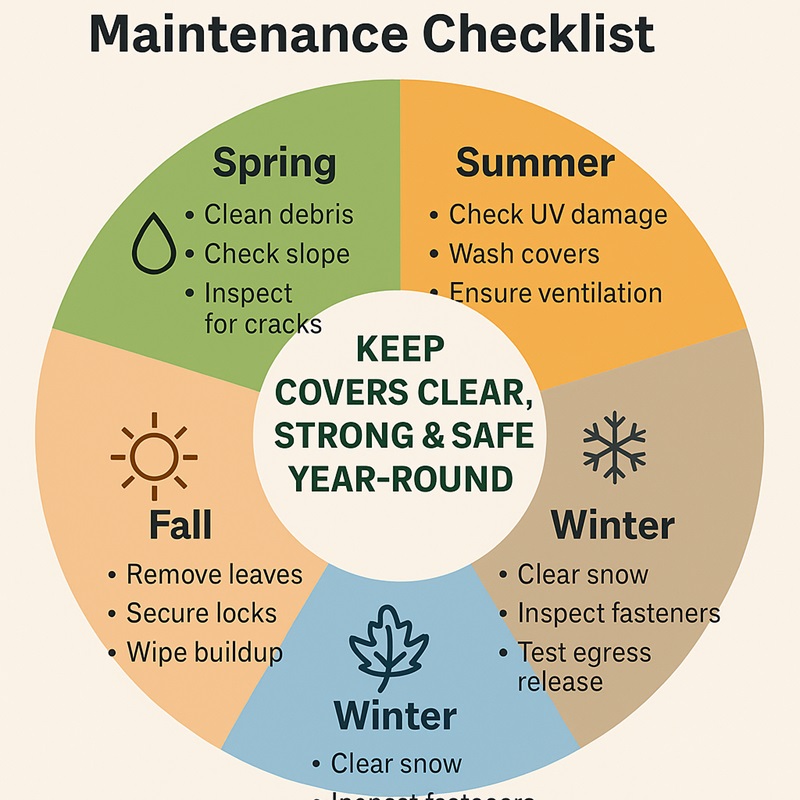Polycarbonate window well covers keep basements safe from flooding, dirt, and accidents while still letting in sunlight. They are tough, impact-resistant, and can last 10–15 years if made with UV protection. Simple seasonal care—like cleaning, checking for cracks, and clearing off snow or leaves—keeps them working well year-round. Compared to acrylic, metal grates, or glass, polycarbonate gives the best mix of safety, clear light, and long-lasting strength for most homes.
Understanding Polycarbonate Window Well Covers
Polycarbonate window well covers do more than block dirt and water. They add safety, save energy, and hold long-term value. Unlike thin plastics that crack, polycarbonate can handle heavy snow, hail, and daily use without losing strength. Many high-quality models include UV protection, which keeps them clear and strong for 10–15 years. Some even come with warranties for extra peace of mind.
Another big benefit is customization. Covers can be made to fit oversized or unusual wells. This window well covers fit stops leaks, blocks debris, and keeps basements dry. Premium covers often use aluminum frames or extra bracing to hold their shape during extreme weather.
Safety is also key. Many modern covers include quick-release systems that meet building codes. These features make sure basement windows still work as emergency exits. This balance of safety, strength, and easy use makes polycarbonate covers one of the best upgrades for any home with a basement.
How Seasons Affect Window Well Covers
Window well covers need only simple care, but the seasons do create different challenges.
- Winter: Snow and ice can freeze covers or make them heavy, which slows down emergency exits. Snow sliding off the roof may also crack or stress the cover.
- Spring & Fall: Leaves, dirt, and small branches collect on top, blocking drainage and light.
- Summer: Strong sunlight and heat expose covers to UV rays that slowly weaken the material.
Even with these challenges, polycarbonate covers remain strong. A quick check and light cleaning each season keep them safe and working.
Why Maintenance Matters
Taking care of your window well covers protects both your home and family. Clean covers prevent clogs, which means less chance of water leaks or basement flooding. An annual check ensures they sit at the right slope and aren’t bent, helping water flow away during storms.
Good maintenance also prevents accidents. Covers act as barriers, stopping kids and pets from falling into deep wells. Keeping them in good condition also improves curb appeal, since neat covers make your home look cared for. Buyers often notice small details like this, which can even raise property value.
Simple steps—like brushing off debris, checking for cracks, and making sure the cover fits well—save money and stress later. With just a little effort, your covers stay safe, strong, and attractive for years.
Seasonal Window Well Cover Maintenance Tips for Polycarbonate Window Well Covers
Spring: Rain and Renewal
Spring brings heavy rain and rising moisture. This can cause mold, mildew, and dirt to build up on covers. To keep them clear and strong, clean them well at the start of the season. Wash off dirt, leaves, and other buildup with mild soap and water. Check for cracks or small damage caused by changing weather. Make sure the covers fit tightly and slope away from the house to stop leaks. A quick spring check helps keep basements dry and covers in good shape.
Summer: Sun and Heat
The summer sun is tough on polycarbonate covers. Strong UV rays can turn the plastic yellow and cloudy over time. Without UV protection, covers may weaken in just a few years. Heat can also warp the shape, letting in dirt or water. High-quality covers have metal frames that prevent bending.
In summer, check for warping or fading. Clean them with soap and water to let in more light and air. Make sure covers fit firmly but still allow airflow to stop wells from overheating. A UV-resistant coating helps keep them clear and durable.
Fall: Leaves and Wind
Fall is the time to get ready for winter storms. Leaves, dust, and webs often collect on covers. Wipe them down and clear out debris. Secure the covers so they don’t shift or blow off during strong winds. If you have an egress release system, make sure it works so you can open the cover quickly in an emergency. A quick wash in fall keeps the covers clean and ready for the colder months.
Winter: Snow and Ice
Winter brings heavy snow and freezing temps. Polycarbonate covers handle the cold better than glass or cheap plastic. They resist cracks from hail, snow, and ice. The smooth surface makes it easier for snow and ice to slide off.
Still, winter care is important. Check the fasteners and make sure snow or ice isn’t blocking the escape route. Clear off large piles of snow to reduce weight. Regular checks after each storm keep covers safe, strong, and ready for emergencies.
Choosing the Right Polycarbonate Window Well Cover
People often ask if Colorado’s wild temperature swings damage polycarbonate window well covers. The answer is no. Polycarbonate expands in heat and contracts in cold, but it is built to handle those changes without losing strength. The bigger issue is sunlight. Over time, UV rays weaken untreated plastic. That’s why the best covers use UV-protected polycarbonate with aluminum support. These features keep covers clear, strong, and stable through hot summers, freezing winters, and sudden shifts in between.
Design also makes a difference. Good covers use oversized screw holes, wide-head rivets, and strong locks. This lets the cover flex with the seasons without cracking at stress points. Pairing UV-protected polycarbonate with rust-resistant aluminum frames gives both strength and clarity that lasts.
Thickness matters too. Thicker covers resist impacts better, whether from falling debris or heavy snow. Stronger material means the cover won’t bend, warp, or crack in tough weather.
By choosing covers with these features, you not only get better protection but also make upkeep easier. A well-built cover lasts longer, works better, and protects your home for years to come.
Cost & Value Analysis
- Average Cost: $100–$500 per cover depending on size and quality.
- Installation: DIY possible, but professional installation averages $200–$400.
- Long-Term Savings: Prevents basement flood damage, which can cost $4,000–$10,000 to repair.
- Home Value: Maintained covers boost curb appeal and signal diligent upkeep to potential buyers.
Polycarbonate vs Other Materials
| Material | Pros | Cons | Lifespan |
| Polycarbonate | Impact-resistant, clear, UV-treated | Higher cost | 10–15 yrs |
| Metal Grates | Strong, pest-proof, durable | Blocks light, heavy | 20+ yrs |
| Acrylic | Clear, cheaper upfront | Scratches easily, brittle | 3–7 yrs |
| Tempered Glass | Crystal clear, aesthetic | Heavy, fragile, costly | 10 yrs |
Polycarbonate strikes the best balance between safety, aesthetics, and durability for most homeowners.
Building Code & Safety Compliance
According to the International Residential Code (IRC 2018, R310.4):
- Window wells with covers must be openable from the inside without tools to allow emergency escape.
- Covers should not obstruct required egress space.
- Quick-release locking systems are recommended for both security and compliance.
Ignoring these guidelines can result in safety risks and potential code violations during home inspections.
Environmental Considerations
- Polycarbonate is recyclable (#7 plastic), though municipal recycling varies—some manufacturers offer take-back programs.
- Longer lifespan reduces waste compared to cheaper plastics needing frequent replacement.
- UV treatments extend durability, lowering overall material consumption over decades.
Quick Maintenance Checklist
- ✅ Clean with mild soap and water every season.
- ✅ Inspect for cracks, slope issues, or yellowing.
- ✅ Clear snow, ice, and debris after storms.
- ✅ Test emergency egress release each season.
- ✅ Reapply UV protectant every 2–3 years for maximum lifespan.
FAQ
Do polycarbonate covers turn yellow?
Yes, untreated covers do. UV-treated covers remain clear for 10+ years.
Can they support the weight of a person?
Quality covers are designed to hold 200–400 lbs, preventing falls.
Do they fit custom wells?
Yes, many manufacturers fabricate custom covers to fit non-standard shapes.
How long do they last?
10–15 years with UV treatment and routine care; cheaper acrylic may last only 3–5 years.
Final Thoughts
Polycarbonate window well covers are a worthwhile investment for homeowners concerned with safety, flood prevention, and property value. With seasonal maintenance, proper selection, and compliance with building codes, they provide long-term reliability. Choosing quality UV-treated materials with strong frames ensures they withstand harsh climates and protect your basement for years to come.






